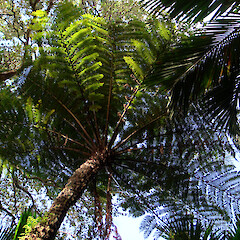Alsophila kermadecensis
Common name
Kermadec tree fern
Synonyms
Cyathea kermadecensis W.R.B. Oliv.;
Family
Cyatheaceae
Flora category
Vascular – Native
Endemic taxon
Yes
Endemic genus
No
Endemic family
No
Structural class
Ferns
NVS code
The National Vegetation Survey (NVS) Databank is a physical archive and electronic databank containing records of over 94,000 vegetation survey plots - including data from over 19,000 permanent plots. NVS maintains a standard set of species code abbreviations that correspond to standard scientific plant names from the Ngä Tipu o Aotearoa - New Zealand Plants database.
CYAKER
Chromosome number
2n = 138
Current conservation status
The conservation status of all known New Zealand vascular plant taxa at the rank of species and below were reassessed in 2017 using the New Zealand Threat Classification System (NZTCS) – more information about this can be found on the NZTCS website. This report includes a statistical summary and brief notes on changes since 2012 and replaces all previous NZTCS lists for vascular plants.
Please note, threat classifications are often suggested by authors when publications fall between NZTCS assessment periods – an interim threat classification status has not been assessed by the NZTCS panel.
- Conservation status of New Zealand indigenous vascular plants, 2017 . 2018. Peter J. de Lange, Jeremy R. Rolfe, John W. Barkla, Shannel P. Courtney, Paul D. Champion, Leon R. Perrie, Sarah M. Beadel, Kerry A. Ford, Ilse Breitwieser, Ines Schönberger, Rowan Hindmarsh-Walls, Peter B. Heenan and Kate Ladley. Department of Conservation. Source: NZTCS and licensed by DOC for reuse under the Creative Commons Attribution 4.0 International licence.
2017 | At Risk – Naturally Uncommon | Qualifiers: IE, OL
Previous conservation statuses
2012 | At Risk – Naturally Uncommon | Qualifiers: IE, OL
2009 | At Risk – Naturally Uncommon | Qualifiers: RC, IE, SO
2004 | Range Restricted
Brief description
Tall tree fern with green-stalked soft leaves to 4 m long inhabiting Raoul Island in the Kermadec Islands. Trunk to 20 m tall, slender, old leaves fall off whole. Leaf stems covered in small star-tipped scales and pointed scales (lens needed). Sporangia arranged in small half capsules underneath fronds.
Distribution
Endemic. Kermadec Islands, Raoul Island only
Habitat
Confined to the higher parts of Raoul Island where it is a locally conspicuous component of ravine, gully, gorge and cliff forest in the wetter part of the island.
Detailed description
Gracile tree fern up to 20 m tall. Trunk slender, often curved, covered with diamond-shaped stipe scars. Stipes slender, copiously invested in woolly hairs and pale brown to brown scales lacking marginal spines. Fronds arching from crown, up to 4 × 2 m, 3-pinnate; dead fronds falling. Primary pinnae up to 400 mm long, dark green to yellow-green above, subcoriaceous to membranous, undersides paler, bearing numerous scales; scale apices terminated by single or stellate spines. Indusia cucullate.
Similar taxa
On Raoul Island this species is sympatric with Alsophila milnei, from which it is easily distinguished by its taller, more slender trunk which lacks a persistent skirt of dead frond and bears numerous rhomboid stipe scars; by the soft rather than coriaceous, raching rather than horizontal fronds, and hood-shaped rather than cup-shaped indusia. The scales on the underside of the pinnae in A. kermadecensis are not curled and are terminated by a single or stellate spine. Alsophila kermadecensis is very closely related to A. cunninghamii, which is common in New Zealand proper and Australia. From that species Alsophila kermadecensis is best distinguished by its clean trunks which lack persistent stipe bases, less divided fronds and by the absence of stellate hairs on the frond undersides.
Propagation technique
Easily grown from spores. Young plants are very cold sensitive and will not tolerant any frost, wind or drought. They are best planted in a warm, sheltered, permanently damp site. Once established this species is very fast growing.
Threats
Not Threatened. Listed because it is a narrow range naturally confined to Raoul Island. In the past it had been regarded as highly threatened but in recent years numerous plants of all different age classes have been found.
Etymology
kermadecensis: From the Kermadec Islands
Where To Buy
Occasionally available from specialist native and general plant nurseries.
Attribution
Fact sheet prepared for NZPCN by P.J. de Lange July 2009. Description adapted from Brownsey & Smith-Dodsworth (2000).
References and further reading
Brownsey PJ, Smith-Dodsworth JC. 2000. New Zealand Ferns and Allied Plants. David Bateman, Auckland, NZ. 168 p.
NZPCN Fact Sheet citation
Please cite as: de Lange, P.J. (Year at time of access): Alsophila kermadecensis Fact Sheet (content continuously updated). New Zealand Plant Conservation Network. https://www.nzpcn.org.nz/flora/species/alsophila-kermadecensis/ (Date website was queried)


